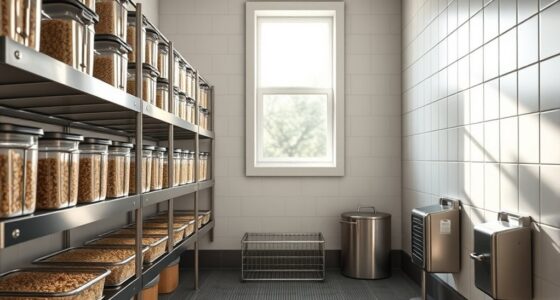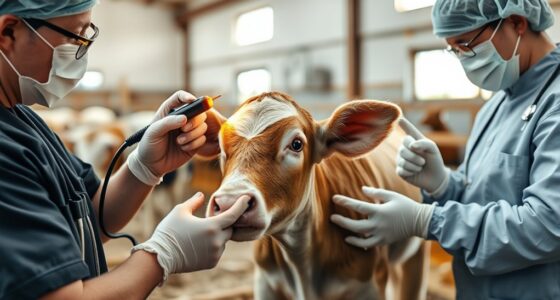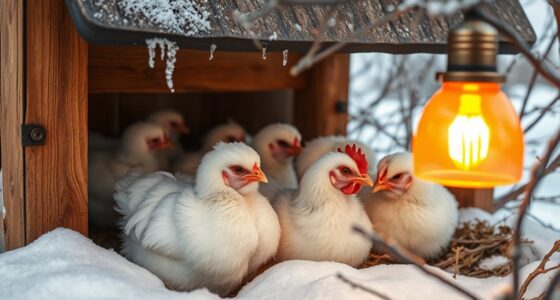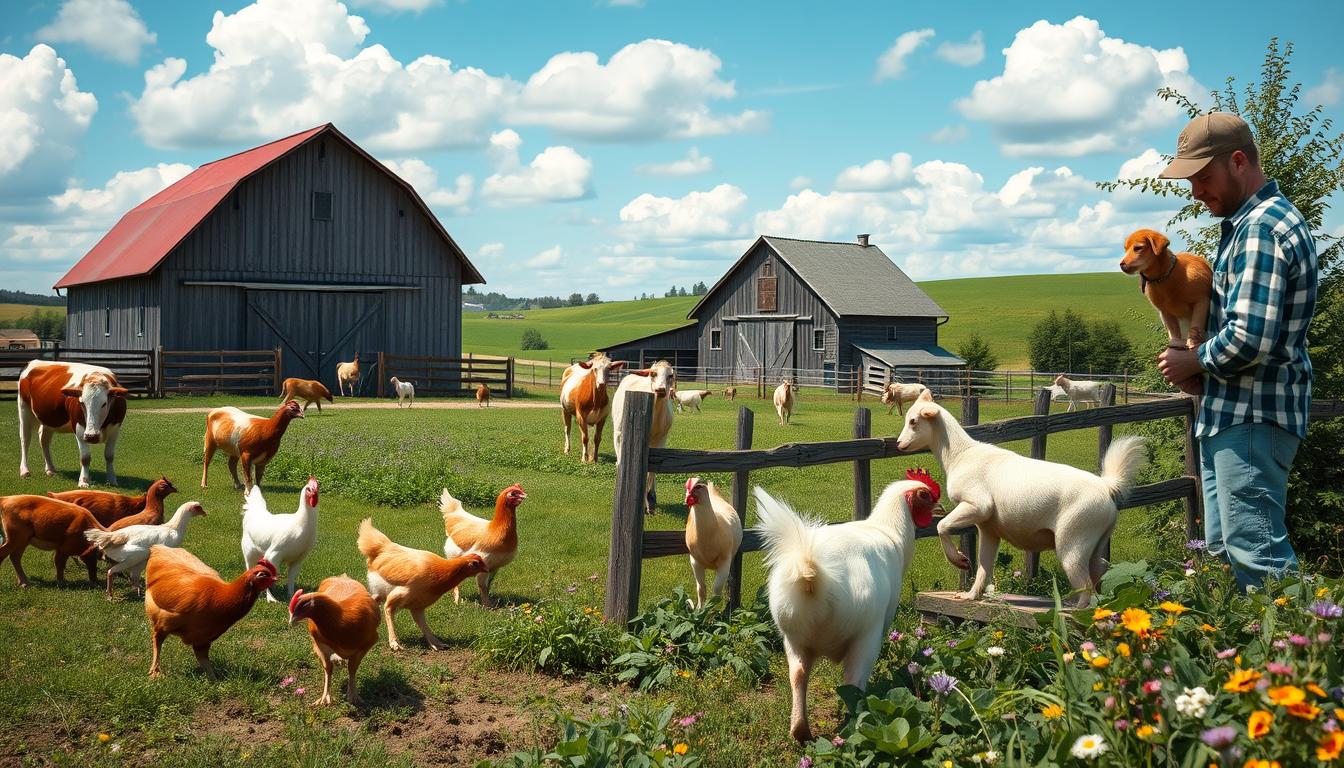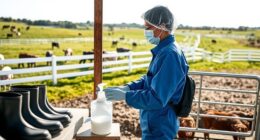When poultry faces heat stress, you’ll notice them behaving differently—like panting heavily, spreading wings, or seeking shade. They might move sluggishly, sit or lie down more often, and show dehydration signs such as dry wattles or sunken eyes. Feed may decrease, egg production drops, and feathers can appear ruffled or greasy. Severe signs include collapse or paralysis. Recognizing these cues early helps prevent serious health issues—continue to explore how to keep your birds comfortable and healthy.
Key Takeaways
- Look for behavioral changes such as lethargy, huddling, and seeking shade.
- Observe respiratory signs like open-mouth breathing, heavy panting, and rapid breathing.
- Monitor water intake and hydration indicators, including dry combs and sunken eyes.
- Check for physical symptoms like dull feathers, swollen skin, and ruffled appearance.
- Watch for reduced egg production, thin shells, and severe signs like collapse or sudden death.
Changes in Poultry Behavior During Hot Weather
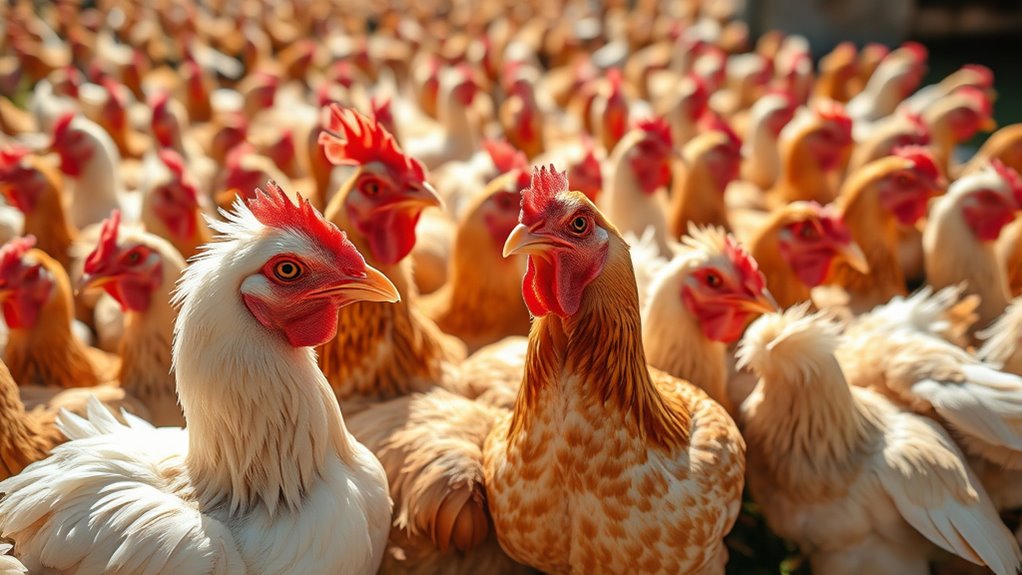
When the weather turns hot, poultry often exhibit noticeable changes in their behavior. You’ll see them become more lethargic, moving slowly and less frequently. They may gather in shaded areas or huddle together to escape the heat. You might notice increased panting or open-mouth breathing, which helps release excess body heat. Some birds may become restless, pacing or trying to find cooler spots in the coop. You could also observe a decrease in activity levels, with chickens spending more time sitting or lying down. These behavioral shifts are signs your poultry are struggling to cope with the high temperatures. Recognizing these cues early helps you take steps to prevent heat stress from worsening, including providing proper ventilation and ensuring access to fresh, cool water.
Alterations in Feed and Water Intake
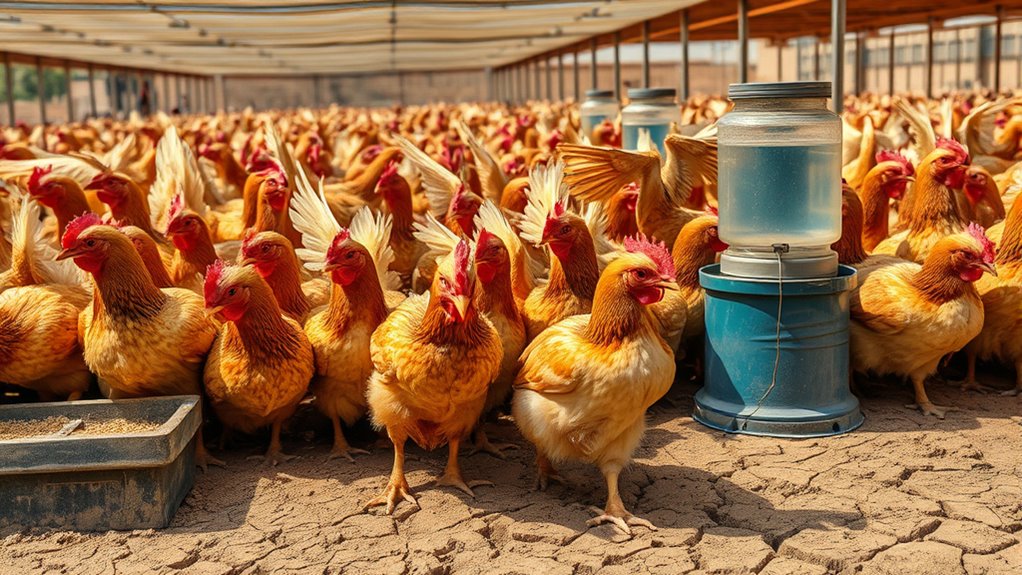
During heat stress, you’ll notice your poultry drinking less water initially, which can quickly lead to dehydration. As temperatures rise, they may start drinking more water to compensate, but overall intake can still fluctuate. Additionally, their feed consumption often decreases, impacting growth and productivity during hot weather.
Reduced Water Consumption
Have you noticed your poultry drinking less water during hot days? Reduced water consumption is a common sign of heat stress. When temperatures rise, birds often instinctively limit their water intake to avoid overheating. This decrease can lead to dehydration, impairing their ability to regulate body temperature and perform essential functions. If your flock is drinking less than usual, it’s a red flag that they’re under heat stress. You might also observe their combs and wattles becoming paler or drier. Keep a close eye on water availability and quality. Ensuring clean, fresh water is always accessible encourages proper hydration. Recognizing this behavior early helps you take steps to cool your birds and prevent more severe health issues.
Increased Water Intake
In some cases, poultry under heat stress may actually increase their water intake rather than decrease it. This behavior occurs as birds try to cool down by compensating for fluid loss through panting and evaporation. You’ll notice they drink more frequently and consume larger volumes of water. This increased intake helps to regulate body temperature and prevent dehydration, but it can also strain water systems if not managed properly. Be alert for signs like excessive drinking combined with other stress indicators, such as open-mouth breathing or lethargy. Ensuring a consistent, clean water supply becomes even more critical during hot weather. Proper hydration supports their overall health and helps mitigate the effects of heat stress, but over-reliance on water intake alone won’t fully address the underlying heat-related issues. Hydration management is essential to prevent further complications in heat-stressed poultry.
Changes in Feed Consumption
Heat stress often causes noticeable changes in poultry’s feed consumption, which can serve as early warning signs. You might observe your birds eating less than usual or showing a sudden decrease in appetite. This decline occurs because high temperatures make digestion uncomfortable, leading birds to conserve energy and reduce intake. Conversely, some poultry may temporarily eat more in an attempt to compensate for increased energy demands. Monitoring feed intake closely helps you identify stress early. Reduced feed consumption can also signal dehydration or overall discomfort. Keep a regular record of how much your birds eat daily, and compare these figures to normal patterns. Sudden changes in feed intake may also indicate Kia Tuning issues affecting overall health. Promptly addressing decreases in feed intake can prevent further health issues and improve your flock’s resilience to heat stress.
Physical Signs: Panting and Open-Mouthed Breathing
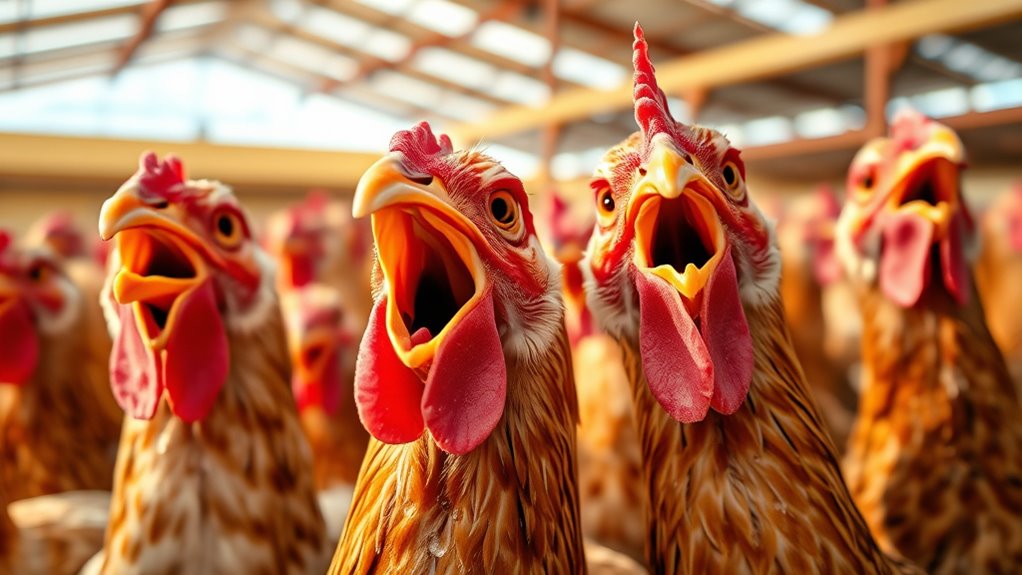
When poultry experience heat stress, they often respond by panting heavily and opening their mouths wide. This rapid breathing helps regulate their body temperature but is a clear sign they’re overheated. You might notice their beaks gaping open, especially during the hottest parts of the day. To better understand, see the table below:
| Behavior | Visual Cue | Purpose |
|---|---|---|
| Heavy Panting | Rapid, shallow breaths | Dissipates heat through respiration |
| Open-Mouthed Breathing | Beaks wide open, labored breaths | Cooling and heat release |
| Restlessness | Fidgeting, moving frequently | Trying to find cooler spots |
| Fluffed Feathers | Puffy feathers, reduced activity | Insulation loss, heat management |
| Reduced Vocalization | Less clucking or calling | Stress response, fatigue |
These signs indicate your poultry are struggling with heat and need relief.
Unusual Postures and Movement Patterns
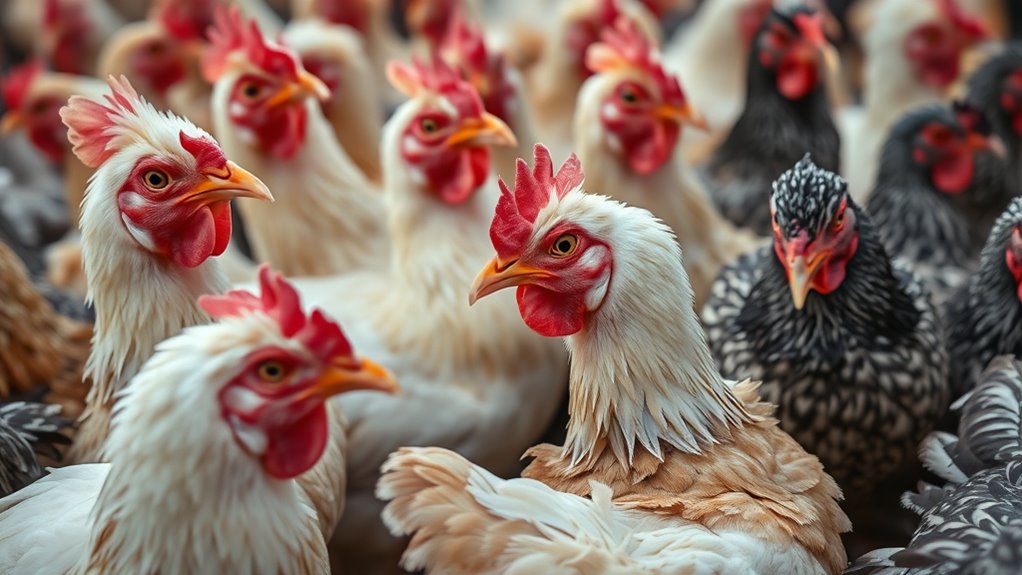
You might notice your poultry adopting unusual postures or movement patterns when they’re stressed by heat. They could be spreading their wings more than usual or moving sluggishly around the coop. These behaviors are clear signs that they’re struggling with the high temperatures.
Panting and Open-Mouth
Poultry often respond to heat stress by adopting unusual postures like open-mouth panting, which helps them cool down. When your birds pant excessively with their beaks open, it’s a clear sign they’re struggling to regulate their body temperature. This behavior increases evaporation from their respiratory tract, providing some relief. You might notice them breathing rapidly or holding their mouths open longer than usual. Open-mouth panting is often accompanied by other signs like fluffed feathers or reduced activity, indicating they’re under heat stress. It’s essential to monitor their breathing pattern closely, especially during hot weather. If you see persistent open-mouth panting, it’s a sign to take immediate action to cool your birds and prevent heat-related illnesses. Additionally, observing changes in body temperature can help determine the severity of heat stress and guide appropriate interventions.
Lethargic or Sluggish Movement
Heat stress can cause poultry to move sluggishly or adopt unusual postures, signaling they’re struggling to cope. You might notice birds hanging their wings or sitting with their heads lowered. They often move slowly, showing little energy or enthusiasm. These behaviors indicate discomfort and distress. Recognizing these signs early helps prevent further health issues. Monitoring poultry behavior closely allows for timely intervention and reduces the risk of severe health consequences.
Wing Spreading Behavior
When poultry spreads its wings unusually or adopts odd postures, it often signals distress caused by heat stress. You might notice birds holding their wings away from their bodies or fanning them rapidly. This behavior helps them dissipate heat by increasing air circulation around their bodies. Sometimes, they stretch or extend their wings in a way that seems exaggerated or unnatural. These movements are involuntary responses to overheating and indicate they’re trying to cool down. If you see your birds frequently spreading their wings or holding them in unusual positions, it’s a clear sign they’re struggling with high temperatures. Addressing this behavior promptly by providing shade, ventilation, or cool water can help reduce their heat stress and prevent further health issues. Additionally, ensuring proper ventilation in their environment is crucial for maintaining a comfortable temperature and preventing heat-related distress.
Visible Dehydration Indicators
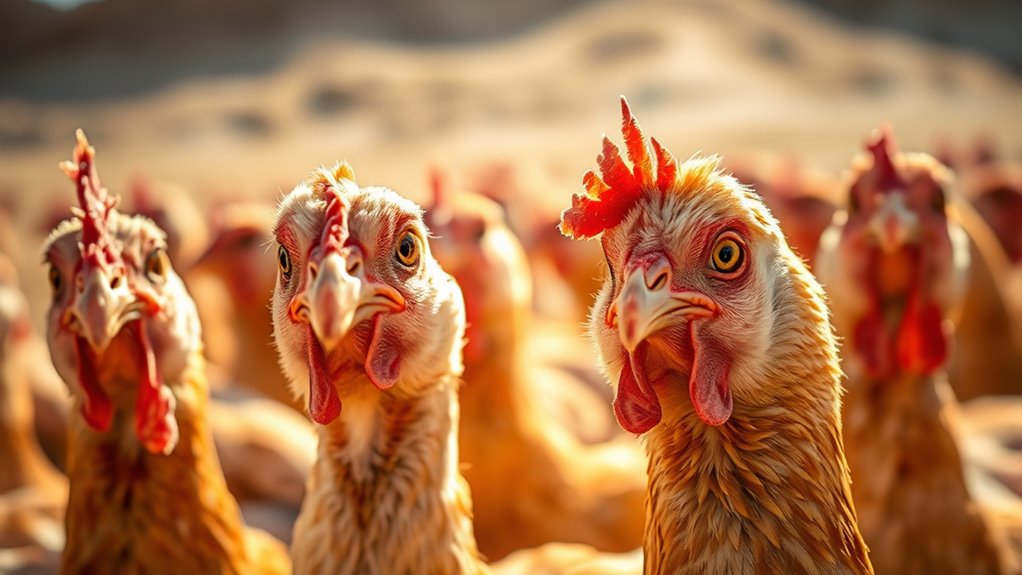
How can you tell if your poultry is dehydrated? Look for visible signs like sunken eyes and dull, flaky combs or wattles. Dehydrated birds often have a dry, sticky beak and their wattles may appear shriveled or discolored. You might notice their skin losing elasticity; when gently pinched, it stays tented instead of bouncing back quickly. Their droppings could become darker and more concentrated, indicating fluid loss. Additionally, the bird’s posture may change—standing with ruffled feathers or appearing lethargic. These signs signal dehydration and suggest your poultry needs immediate access to clean water. Recognizing these indicators early helps prevent more severe heat stress consequences and keeps your flock healthy during hot weather. Understanding dehydration is crucial for effective management and timely intervention.
Reduced Egg Production and Quality
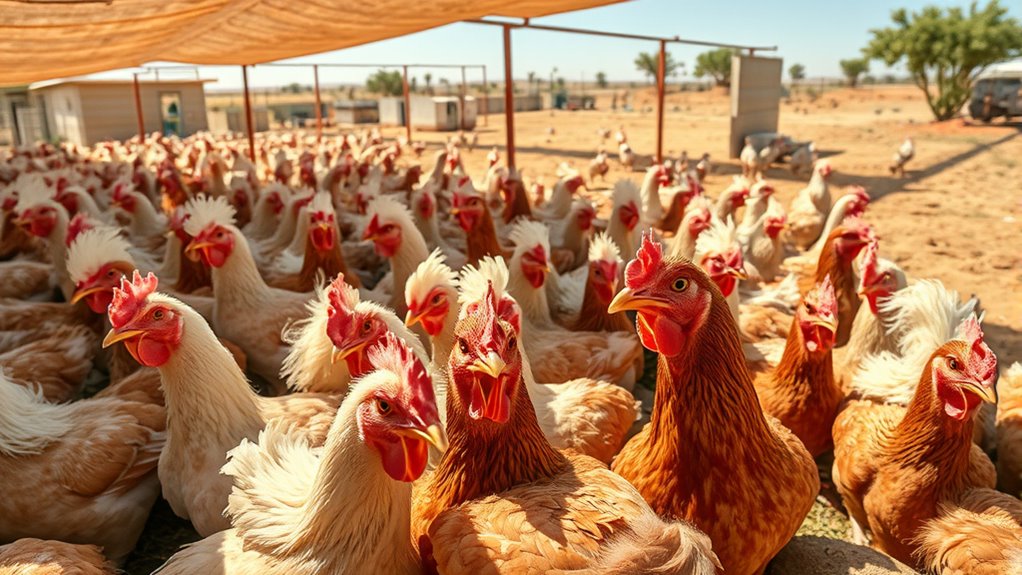
Reduced egg production and quality are common early signs that your poultry are experiencing heat stress. When temperatures rise, hens often lay fewer eggs, and those eggs may be smaller or have thin shells. You might notice a decline in overall egg output, which can impact your farm’s productivity. Additionally, the eggs you do collect could have irregular shapes or cracks, indicating that the hens’ calcium absorption is compromised. Heat stress causes hens to divert energy toward cooling themselves, leaving less energy available for reproduction. If you observe a sudden drop in egg numbers or a deterioration in egg quality, it’s a clear sign that the environment is too hot for your flock. Recognizing heat stress signs early can help you take prompt actions to mitigate further decline and keep your hens healthy.
Lethargy and Decreased Activity Levels
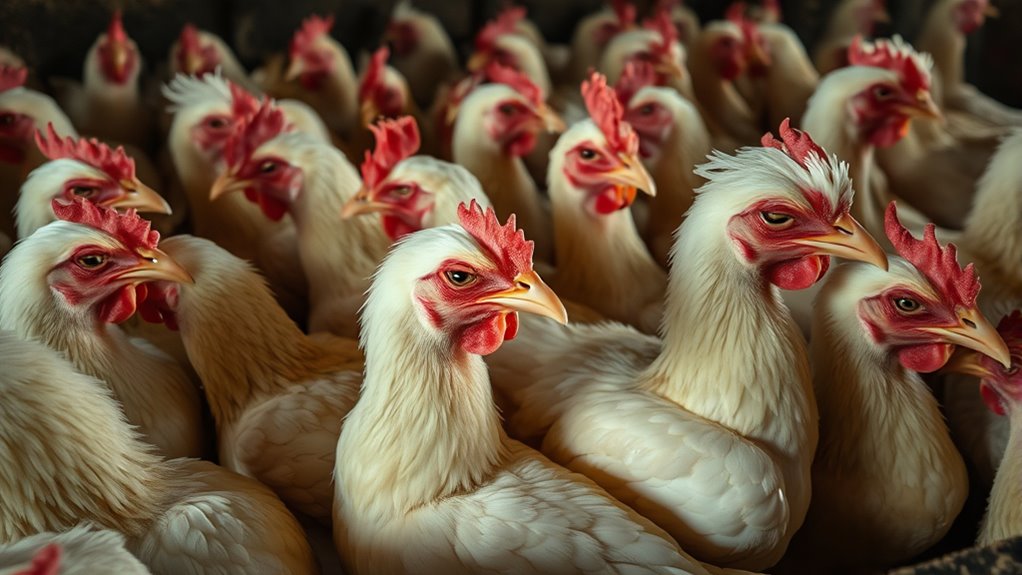
Heat stress not only impacts egg production but also considerably affects your hens’ behavior and energy levels. When they experience high temperatures, you’ll notice they become noticeably sluggish and less active. Instead of their usual foraging or social behaviors, they might remain motionless or sit quietly in shaded areas. Their activity levels drop as they conserve energy to cope with the heat. You may observe them spending more time panting or spreading their wings to dissipate heat, but overall, movement decreases. This lethargy is a clear sign that your flock is struggling with heat stress. Recognizing these behavioral changes early helps you take timely steps to cool them down and prevent further health issues. Understanding heat stress is essential for maintaining a healthy and productive flock during hot weather.
Skin and Feather Condition Changes
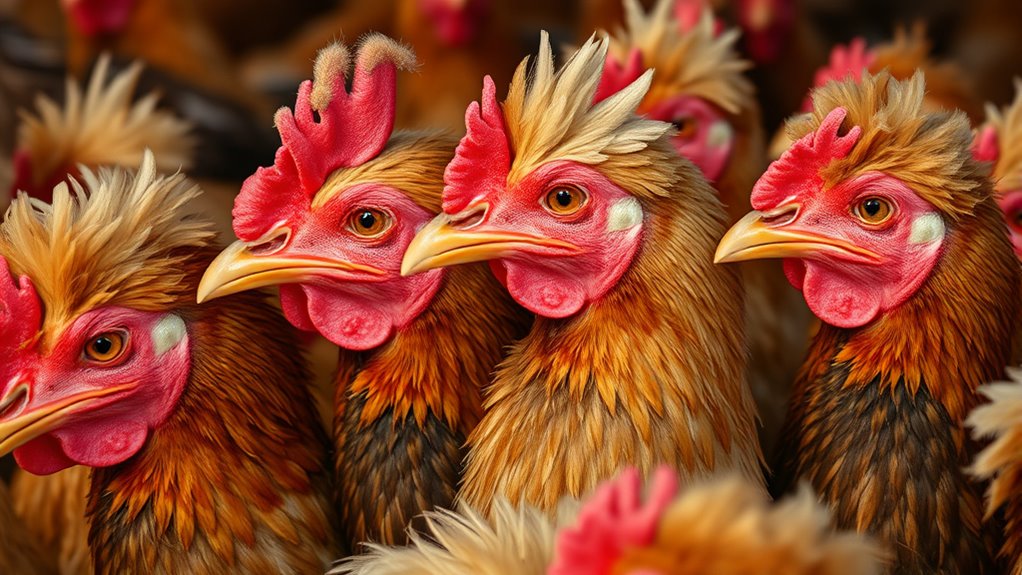
When poultry experience heat stress, their skin and feather condition often show noticeable changes. You might see feathers becoming ruffled, greasy, or dull. The skin may appear reddened or swollen, indicating irritation. Feathers may also lift or stick together, reducing insulation and cooling efficiency. You can use this table to identify different signs:
| Sign | Description | Possible Cause |
|---|---|---|
| Dull, greasy feathers | Feathers lose shine, appear oily | Excess moisture or stress |
| Ruffled feathers | Disorganized, standing out from the body | Heat discomfort |
| Reddened skin | Inflamed, discolored areas | Skin irritation |
| Feathers sticking together | Clumped feathers reduce airflow | Excess humidity or oil |
| Feather loss | Thinning or bald patches | Stress or moulting |
Monitoring these signs helps you identify heat stress early, especially since proper ventilation can significantly mitigate such issues.
Signs of Severe Heat Stress and Emergency Indicators

Severe heat stress in poultry quickly leads to critical health issues and requires immediate action. If your birds become lethargic, unresponsive, or show labored breathing, it’s a red flag that the situation has escalated. Look for wings held away from the body, open-mouth breathing, or gasping—signs of distress. Pale or bluish combs and wattles indicate oxygen deprivation. Birds may also stagger, collapse, or die suddenly if heat stress worsens. Excessive panting and weakness are clear emergency indicators. If you observe any of these signs, act immediately by cooling the environment, providing fresh water, and seeking veterinary assistance. Ignoring these signs can lead to rapid mortality, so quick response is vital to save your poultry’s lives.
Frequently Asked Questions
How Can I Prevent Heat Stress in My Poultry?
To prevent heat stress in your poultry, make certain they have plenty of cool, clean water available at all times. Provide adequate shade and good ventilation in their housing to keep temperatures down. Adjust feeding times to cooler parts of the day and avoid overcrowding, which can increase heat buildup. Using fans or misters can also help keep the environment comfortable, reducing the risk of heat stress and keeping your birds healthy.
Are Certain Poultry Breeds More Heat-Tolerant?
Yes, some poultry breeds are more heat-tolerant than others. For example, breeds like Leghorns, Andalusians, and Buff Orpingtons handle higher temperatures better due to their genetic traits. You should consider choosing these breeds if you live in a hot climate. Additionally, providing ample shade, ventilation, and fresh water helps your poultry stay comfortable and reduces heat stress, regardless of breed.
What Is the Ideal Temperature Range for Poultry?
Imagine a cozy, sunlit coop where the temperature stays between 65 to 75°F. That’s your ideal range, keeping your poultry comfortable and healthy. When it climbs above 80°F, they start panting and spreading wings to cool down. Below 60°F, they may shiver or become sluggish. Maintaining this range guarantees your flock stays active, stress-free, and productive, thriving under your attentive care.
How Often Should I Check My Poultry During a Heatwave?
During a heatwave, you should check your poultry at least every 2 to 3 hours. Keep an eye on their behavior, such as panting, spreading wings, or lethargy, and monitor for signs of dehydration or distress. Make sure they have access to fresh water and shade constantly. Frequent checks help you catch early signs of heat stress, so you can take quick action to keep them safe and comfortable.
Can Heat Stress Affect Poultry Mortality Rates?
A gentle reminder that heat stress can indeed influence poultry mortality rates, especially during extreme weather. When temperatures soar, your birds may struggle to regulate their body heat, leading to potential health declines. By providing ample shade, water, and ventilation, you help create a more comfortable environment, reducing risks. Staying vigilant and proactive guarantees your flock remains healthy and minimizes the chance of losses due to heat-related issues.
Conclusion
Just like Icarus flew too close to the sun, your poultry can suffer from heat stress if you don’t watch for signs. By paying attention to their behavior, physical cues, and production changes, you can act before it’s too late. Think of yourself as their guardian angel, guiding them safely through the heat. Stay vigilant, respond promptly, and keep your flock cool—so they can thrive even under the summer sun.



